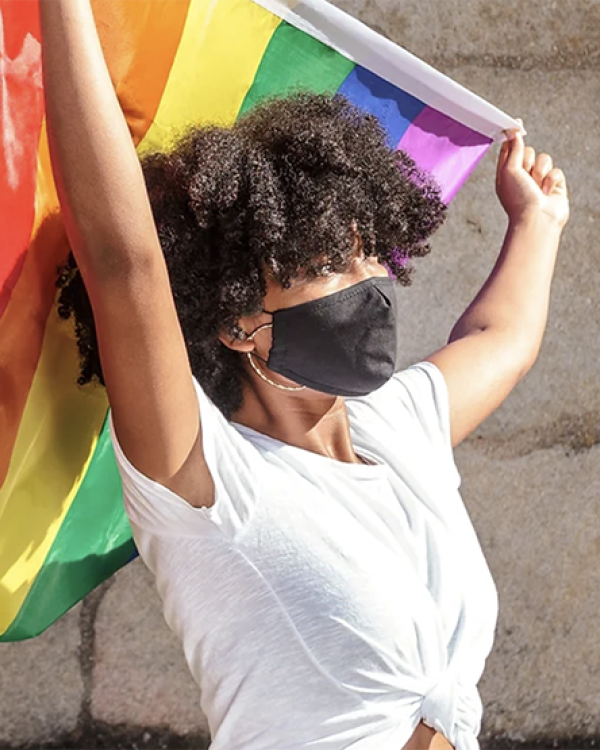
For Isaiah Jay Jones, a first generation doctoral student in the Department of Counseling, Clinical, and School Psychology (CCSP), joining the team working on the California Department of Public Health’s (CDPH) LBTQ Health Equity Initiative wasn’t just an easy choice, it was an exciting one. “The LBTQ Health Equity Initiative is really a culmination of our team’s interests, practice, and career goals,” they share. “I couldn’t help but want to be a part of that!” Jacquelyn Chin, another CCSP doctoral student brought onto the project, shares Jones’ enthusiasm, claiming, “Community-based organizations are one of the most effective resources for supporting sexual-minority communities—especially those of color.” The initiative is working on getting those projects funded and evaluated, she explains. “It’s so exciting getting to be a part of that work.”
The directive aims to improve equitable access to healthcare for LBTQ women, trans men, and nonbinary people, particularly youth, the elderly, and BIPOC community members. Despite the health inequities these populations face—stemming from a lack of culturally responsive care, deeply rooted systemic anti-LBTQ bias, and structural determinants of health like food security, safe housing, and access to healthcare—there remains an alarming lack of medical services and research tailored to these populations.
LBTQ community members are hurt from the “stigma and prejudice within existing institutions, lack of awareness or resources because of that, and the resulting lack of safety,” Jones explains. Insufficient representation in leadership and educational positions in the field and a lack of specificity in training LBTQ community providers to serve their own communities, according to Chin, exacerbate LBTQ healthcare inequities. Grant administrator Eric Cortez echoes his colleagues: there is a “disconnect between medical providers and gender and sexual minority population,” many of whom do not fully understand the needs of these community members.
“We know that structural determinants of health are so important and rarely considered,” explains PI Dr. Alison Cerezo. Among those structural determinants are factors like food security, safe housing, access to healthcare, language access, and documentation status. “Ahead of even discussing LBTQ identity,” Dr. Cerezo continues, truly supporting and serving these communities requires “understanding and addressing health needs at the intersections of lived experience.” Equitable healthcare cannot be a reality for communities inadequately served by the current healthcare system without a complete understanding of how societal factors beyond healthcare systems impact community wellbeing.
Working from this intersectional understanding of the healthcare inequities sexual minority populations face, the team behind the CDPH LBTQ Health Equity directive is taking a community-based approach. “Our main goal is to engage in servant leadership for and with the community,” Dr. Cerezo explains. “It might be the case that some papers are developed in response to this work, but that isn’t our main goal unless the community wants that to be.” Jones points out there have been gaps of up to 17 years between scientific research and public implementation in the mental healthcare field. Community stakeholders—such as health navigators working with schools, clinics, and grassroots community support systems—often serve as a bridge between individuals and the healthcare system and have earned community trust by doing this work for years. By focusing on working with and empowering these stakeholders, the members on the LBTQ Health Equity Initiative team aim to bridge that gap.
But the group also knows it’s just one part of this work. “As a public health professional and scholar, I think we all could stand to exercise more humility,” points out Paris DaSilva, the Technical Research Coordinator of the project. “Our patients, participants, and community members have first-hand knowledge and experience. They live the disparity in their day-to-day lives. So it would behoove us all to spend more time listening to their perspectives, ideas, and voices on addressing health inequities and disparities in general.”
Currently, the team, with DaSilva coordinating, has been putting together a research manual focused on how organizations can work to bridge health equity. Chin explains that the manual will “cover various methods (e.g. quantitative, qualitative), the basics of research, needs assessments, and the process of empowerment evaluation in language that feels really accessible for the contractors.” In addition to the manual, Jones will be a resource community stakeholders can turn to for technical support, research methodology, and strategizing. The initiative, which also includes CCSP students Amaranta Ramirez, M.A., Nicole Ramirez, and David Rivera, M.A, meets biweekly with the research team and monthly with the evaluation team. For the duration of the project, Cortez will manage and distribute the initiative’s funds.
What is most exciting about the initiative, however, is that it truly puts the needs of the community first. As researchers interested in supporting the community, Dr. Cerezo says, “We can get out of the way and be led by community organizers and health advocates who have been doing this work for years.”
Ultimately, Jones shares, collaborating with community stakeholders through the project’s commitment to health equity, empowerment, and intersectionality allows all the researchers to fulfill the basic goal of the initiative: “making sure those who should benefit most actually do.”